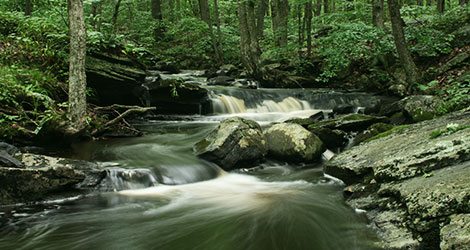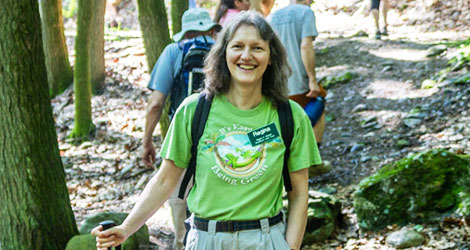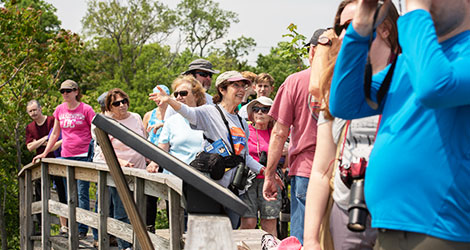
Chasing Winter’s Allure
An ode to snowshoeing.
By Jennifer Sprague
A glistening blanket of fresh white snow covers the forest floor, hiding all evidence of autumn. As the breeze hits the treetops, tiny flakes fall like glitter, catching the sunlight as they dance their way to the forest floor.
The allure of winter calls me to explore. Relishing the solitude of the snowy woods, I let my thoughts slowly float away. It’s just me and the quiet landscape. The only sound I hear is the clip-clap, clip-clap of my snowshoes. The air is crisp, and my nose is cold, but my body stays warm as I move through the forest. My arms automatically know what to do, planting my poles in soft powder beside me.
I grew up loving winter in upstate New York—building snow forts, sledding, skiing, and ice skating on a nearby pond. But I didn’t try snowshoeing until I was in my 30s. At the time, I didn’t know anyone who snowshoed or where to borrow gear, so I asked for a used pair of snowshoes for Christmas. Snowshoeing quickly became one of my favorite outdoor activities; an outlet to beat the cabin fever of winter. A decade later, I am still plodding along on the same pre-loved pair.
Since I began snowshoeing, several of my friends and relatives have also taken up the sport. The learning curve is far less steep than skiing or snowboarding, no lessons are required, and if you are comfortable with your balance while walking, you can learn how to snowshoe. It’s a great wintertime activity for people of all ages and fitness levels. My parents, who are in their 60s, regularly snowshoe in the woods behind their home; my sister’s child took up the sport when they were only six years old.
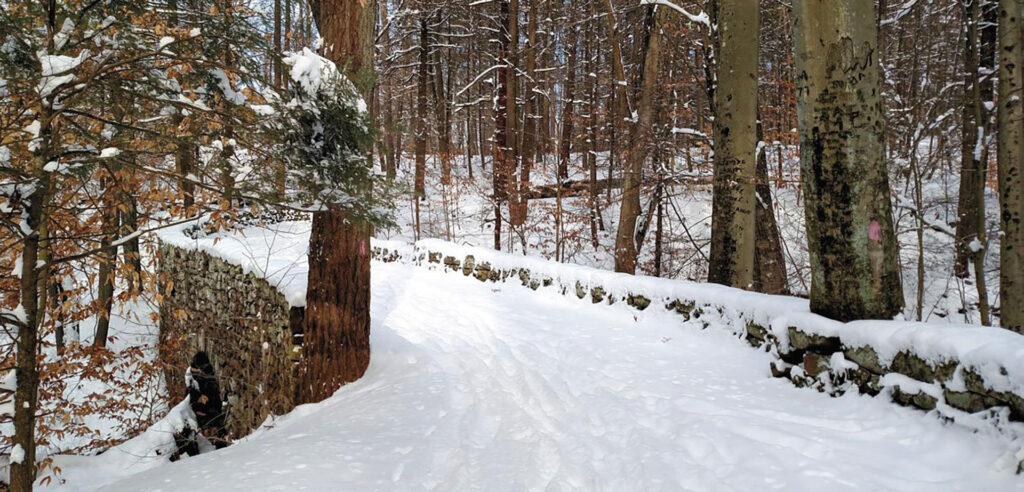
A snowy trail at Wadsworth Falls State Park.
Selecting your first pair of snowshoes
If you plan on heading to rolling or mountainous terrain, you will want a pair of snowshoes with moderately aggressive to aggressive crampons. In steep terrain, you may also want a heel lift. On flat terrain, a basic pair with modest crampons will do.
A heavier person requires more flotation, or a larger-sized shoe. Snowshoes are measured by length and typically range from 21-to-36 inches. If you’re between sizes, a larger size will give you more flotation, while a smaller size will offer more maneuverability. Think about your snowshoeing goals and the conditions you’re most likely to encounter. More flotation is generally desirable in deep powder conditions, while less is needed for packed trails.
The prices of snowshoes can vary significantly. High end gear often means a higher-end price, but a decent beginner pair shouldn’t break the bank. Gently used shoes and poles will work just fine for most conditions! Check online gear trade sites or used goods stores for a pair of pre-loved snowshoes.

Exploring Lake Wintergreen in winter.

Exploring Lake Wintergreen in winter.
I love a leisurely pace on flat terrain, but also the heart-pumping challenge of a steep uphill climb. Winter descents are much kinder on the knees, with snowshoes absorbing some of the shock of rough and rocky trails. It’s a great workout and a way to see stunning landscapes from a unique wintry perspective. When I am alone in the woods, I find snowshoeing can be a meditative experience; with friends, it becomes a grand adventure.
Connecticut offers many hidden gems for snowshoeing. A few of my favorites are the Highlawn Forest and Wadsworth Falls State Park, both near Middletown; Lake Wintergreen at West Rock Ridge State Park in Hamden; and the grounds of the Hill-Stead Museum in Farmington. At the Highlawn Forest, located at CPFA Headquarters in Rockfall, you’ll find a handful of trails, including the 2.2-mile Herbert’s Way, a relatively flat loop that winds through a mature hardwood forest and a former Christmas tree farm that has grown into row after row of towering conifers. Just down the street, at Wadsworth Falls State Park, you can pause at the covered bridge before heading to two waterfalls. Here you’re likely to see other winter enthusiasts on their cross-country skis and fat bikes. You can also access the trails at the Wadsworth Mansion’s Parklands, which are open to the public daily from sunrise to sunset.
Heading south to Hamden, the 1.5-mile loop around Lake Wintergreen takes you past rocky outcroppings and views of the icy lake. For a longer outing, you can access additional trails in West Rock Ridge State Park, including the popular Blue-Blazed Regicides Trail. In Farmington, the Hill-Stead Museum offers three miles of trails that connect to the Blue-Blazed Metacomet Trail.
While Connecticut offers many parks and trails ideal for snowshoeing, a rapidly changing climate has made finding good snow more challenging in recent years. The local winter sports industry is adapting to the impacts of climate change. Some downhill ski areas with snowmaking technology offer uphill passes for snowshoers, which can be an option if natural snow is scarce. Nordic centers typically offer snowshoe passes and rentals, and some offer snowmaking and lighting. If you’re seeking pristine powder, an adventure to northern New England might be for you. Last winter, during a snow drought here in Connecticut, I headed north to Vermont and New Hampshire where snow was more abundant. One of my favorite places to snowshoe is the AMC Highland Center in Crawford Notch in the White Mountains, where guests can borrow snowshoes, boots, and clothing from their L.L. Bean Gear Room.
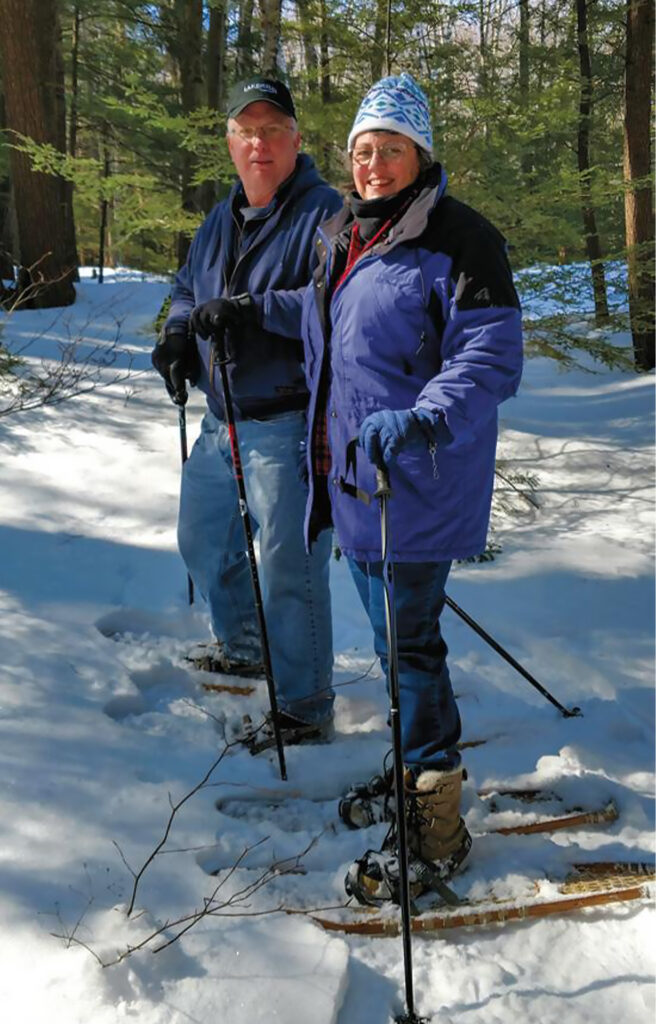
The author’s parents in Vermont.

The author’s parents in Vermont.
If you’re looking to gear up for a snowshoe adventure, your needs will depend on your intended terrain. In addition to snowshoes, I find ski poles handy for balance, probing the terrain for unstable conditions, and helping you to get up when you fall. They also serve as great mitten holders. The rest of your gear can likely be repurposed if you hike or ski. I find that the clothing I wear to shovel my driveway works for a local snowshoe hike, including a waterproof outer layer, a warm hat, gloves or mittens, waterproof boots, and wool socks. If you plan to explore more mountainous or backcountry terrain, you may need to invest in more technical gear.
You’ll also want to consider safety and emergency gear. When adventuring outdoors, I try to always carry the 10 essentials: nutrition, hydration, insulation, sun protection, illumination, navigation, fire, repair kit, first aid, and emergency shelter. It gets dark early in the winter, and you never know when a delay or injury could keep you outdoors longer than expected. Carry a small backpack with your necessary items and throw in a Thermos of hot cocoa for good measure. I find that winter adventures are always better with some cocoa.
Winter in New England can be spectacular, and snowshoeing is one of the best ways to experience this magical season in all her glory. The Farmer’s Almanac is predicting above-average snowfall this year, so if you haven’t tried snowshoeing yet, this is your opportunity. And if you are looking for a reason to love winter, snowshoeing just might be your sport.
Jennifer Sprague is a marketing professional and freelance writer. She serves on the board of the Meriden Land Trust. Her favorite outdoor activities are camping and (you guessed it) snowshoeing.

